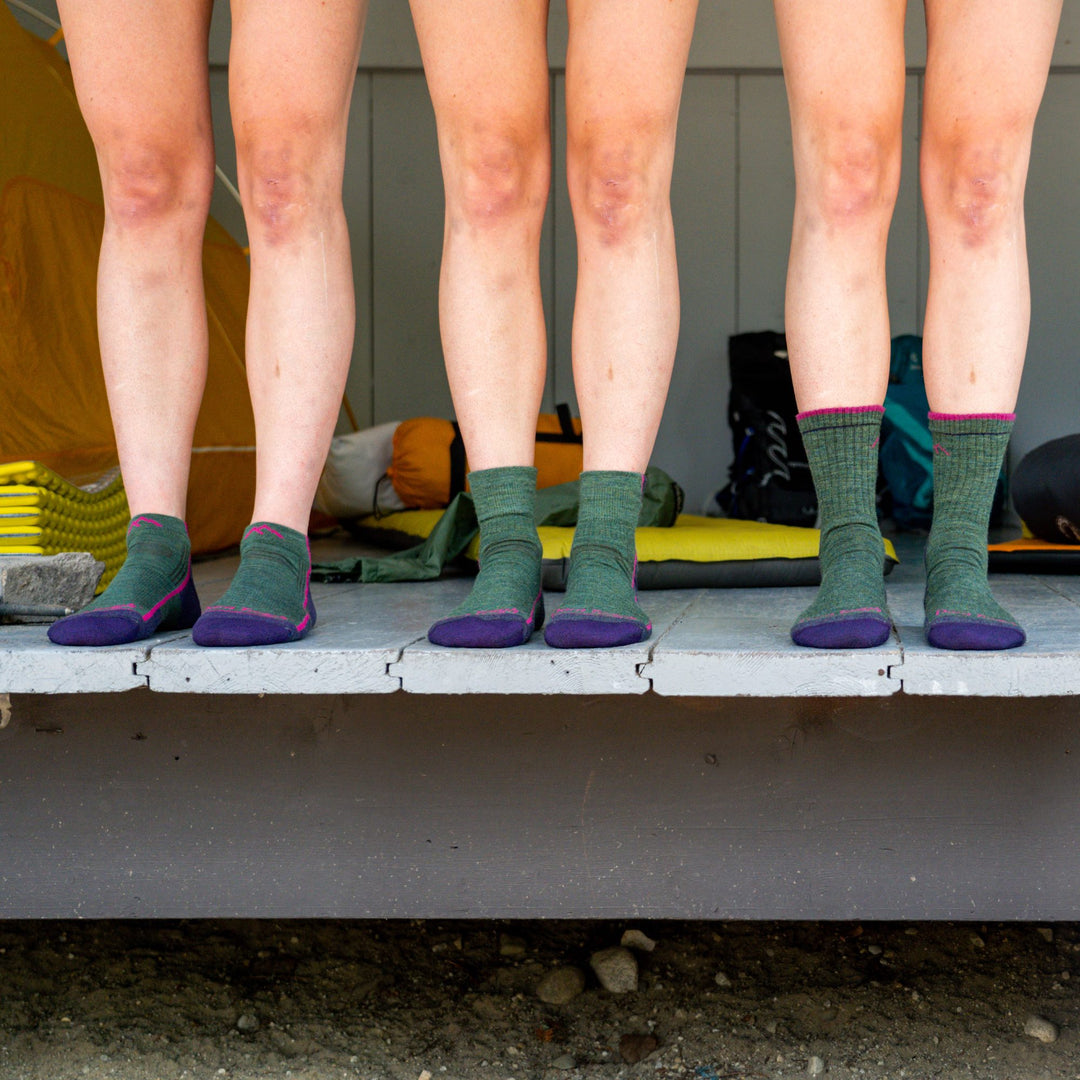Comparing Sock Materials: Merino Wool vs. Wool vs. Synthetics vs. Cotton

Love this amazing illustration of a Merino sheep conquering all other sock materials? Us too. It was created by Sarah Rosedahl. You can check out more of Sarah's artwork here.
For intrepid wanderers and fearless warriors of the great outdoors, there is little debate over which sock material is best for your feet. Merino Wool is nature’s most befitting gift for active sock wearers – it’s breathable, moisture wicking, and thermoregulating. But how does it compare to other popular sock materials like wool, synthetics, and cotton?
Merino Wool offers immense benefits for aspiring off-the-couch champions, professional athletes, and pioneers of every physical pursuit – including hiking, walking, running, biking, skiing, even kicking back at home with your feet up (because lounging can be strenuous, too).
So, if you’re averse to the wonders of Merino Wool, let us be the first to set the record straight. At Darn Tough, we consider Merino Wool to be one of the master strains of all sock materials. When it’s spun together with Nylon and Lycra Spandex, it creates a longer lasting sock that strengthens wear zones and holds its fit for days. We're taking a look at how Merino Wool stacks up against other sock materials.
What Is Merino Wool?
Merino Wool comes from the Merino breed of sheep descending from high-elevation areas in Australia and New Zealand. The Merino breed’s wool is made up of super soft, microscopic fibers that are naturally moisture wicking – which is why these sheep thrive in wet and moist conditions. The rain and moisture common in these areas doesn’t affect them because their fuzzy overcoats offer a protective barrier against the elements. Can ewe believe that?

Merino fibers are almost half as thick as human hair fibers, but twice (if not thrice) as durable and resilient. So, even when it’s spun together hundreds of times, Merino Wool still won’t break – that’s the power of Merino.
Fun facts about Merino Wool fibers:
- Merino fibers can be twisted and folded up to 20,000 times without breaking. Take cotton, for example, which can only bend back on itself 3,200 times before ripping. Or silk which will usually break after 1,800 times folded.
- Merino fibers are naturally crimped – or coiled – which help give them their elasticity. This spring-like attribute of Merino Wool gives it a reflexive, pseudo-permanent memory that rebounds and snaps back into place if disturbed during rigorous activity.
Comparing Performance Sock Materials
Proper preparation prevents poor performance, including finding a pair of reliable socks that you can trust. Whether you’re lining up to race or dropping into fresh powder, your choice of socks could make or break your experience. Performance comes in many shapes and sizes and looks different for each wearer, so we recommend finding a sock that best suits your preferred choice of activity.

Naturally (pun intended), Merino Wool is at the top of our list and our perennial first choice for aiding in all-season performance. But with so many common sock materials fluttering around the realm of sports and lifestyle, it can be intimidating to figure out which fabric is best fit for your feet and why. But we know the truth. And even though the Merino Wool we knit is expensive, its benefits – including being Guaranteed for Life in our socks – far outweigh its cost.
Here, we’ve compared some of the most common performance sock materials against Merino Wool to help you decide why Merino is most befitting for your feet:
Merino vs. Wool
Different types of wool – namely Merino Wool and coarse wool – feature opposing fiber weights that influence what that material will feel like against your skin. Unlike traditional coarse wool (which is often associated as being itchy and rough), Merino Wool is much thinner and softer, making it less agitating, less scratchy, and more comfortable on your skin.
Merino fibers measure in diameter anywhere from 24 microns to 15 microns and below, while regular wool expands well beyond 40 microns. In this case, one micron is equal to one millionth of a meter. That means Merino Wool is thinner than regular wool, while also maintaining its durability and resiliency.

Merino fibers are also much lighter than traditional wool fibers and allow for more unrestricted movement thanks to its flexible molecular structure.
So although both materials derive from sheep, Merino Wool is an ultra-fine, super soft variant of wool that is exclusive to the Merino breed of sheep. Merino is soft, comfortable, and light, ultimately giving you the flex and feel you need to ascend the ranks of performance without thrashing your feet.
Merino vs. Polyester
Polyester is a synthetic material made from petroleum. Both polyester and Merino Wool are materials commonly used to knit base layers, hats, socks, and gloves. Praised for its affordability and quick-drying characteristics, Polyester is a common choice of threads for runners and wearers seeking function over longevity.
But polyester only mimics what Merino does naturally. Sheep have been running and hiking in wool for over 10,000 years – a man-made fabric can’t beat a track record like that. So, if you’re privy to the idea of multi-day hiking or mountaineering, Merino Wool is the gold standard for all active wear – it’s more breathable, durable, and provides serious odor-control that rivals any other material on the planet.
Polyester doesn’t absorb as much as other materials, it’s not as resistant to oily stains, and it is known to leave behind spots and blemishes that are hard to remove. It’s also difficult to dye – which limits the variety of colors for polyester socks – and experiences crimp loss (gets tangled easily) the older the material gets.
Merino vs. Nylon
Nylon is another synthetic material that’s made from petroleum. And like polyester, it’s revered for its silkiness and quick-drying capabilities.
All Darn Tough socks are knit using a combination of Merino Wool and Nylon, which helps give our products their patented fit and durability. So, even though Nylon is not nearly as naturally-enriching as Merino Wool, it provides an addition of high tensile strength and resilience that helps make our socks some of the most durable for all-season performance activity.

So, yes, Nylon is good for socks, but it’s at its best when paired with Merino Wool (like in our socks) as opposed to it being the main fiber. On its own, Nylon will eventually fade in color and has problems with bleaching.
Merino vs. Silk
Silk is expensive and rarely used by hikers as their go-to fabric, but it still offers great performance and wicks moisture without absorbing too much weight in water. Silk is naturally odor-resistant, and like Merino Wool, actively fights back against odors and feels heavenly against your skin.
If you’re keen on trying something new and don’t mind spending an extra buck (or two) on base-layer clothing, silk is a viable option. Just be prepared to explain yourself to the next set of hikers you see at the trail head. You might even consider sharing this blog post with them to help validate your spending habits.
Overall, silk is durable and can help regulate body temperature (just not as well as Merino Wool can). So, if you’re wearing only silk during the winter, it will certainly keep you warm, but it won’t be able to withstand regular wear and tear. It’s easily damaged by the sun and is highly susceptible to the elements.
Another reason to choose wool clothing? In addition to being more durable, high quality Merino fibers are up to three times softer than natural silk, giving it the inherent ability to rest calmly on your skin.
Merino vs. Spandex
Spandex – like the Lycra Spandex we use in knitting our socks – is celebrated for its extraordinary elasticity. You’ll commonly see road bikers donning a full-bodied spandex compression suit to help improve their aerodynamics when in the saddle, but Spandex is universally used as a material to add a little bit of flex to common threads like underwear and waistbands. It’s lightweight and pliant, making it an ideal choice for sportswear and an added superlative to our best hiking socks.

That said, you wouldn’t want to wear a sock that’s only made of Spandex, as this material is more of a supporting fiber (and our socks are better because of it). By itself, Spandex is not the most breathable fabric and will stick to your body if it gets too wet. It’s also sensitive to heat, which makes it less than ideal for fun in the sun during the summer season.
Synthetic Sock Options We Offer
If you're looking for non-wool, vegan socks, we do knit select Darn Tough styles using completely synthetic fibers.

Thermolite Socks
Thermolite® is one of our synthetic alternatives. Thermolite socks are engineered to be warm and dry fast, making it a great option for snow sports like riding and skiing.
Thermolite's lightweight construction is best suited for long days on your feet, offering a next-to-skin fit. Plus, it’s insulated and reinforced for durability, making Thermolite a top-tier synthetic sock material that you can trust on the mountain and deep in the backcountry.
Coolmax Socks
Coolmax® is another synthetic fabric that we use to knit select lightweight hiking and runner socks. This material actively moves moisture away from the skin and keeps your feet dry, especially in warm conditions. Like Thermolite, Coolmax socks are also vegan-friendly.
The name suggests a multitude of airy and breathable characteristics, including keeping the air flowing to your feet and toes even while you’re moving fast. This fabric pairs best with athletic sneakers, running shoes, and hiking boots, and features some unique colorways that’ll add spunk to every step you take.
Emerging Sock Materials
While Merino Wool remains our top material choice to knit socks with, there are a few emerging products that have been breaking ground as leaders of the new school – most notably Alpaca and Bamboo.

We don’t have Bamboo or Alpaca at Darn Tough (at least not yet anyway), but rest assured our Product team is always looking into any new fibers worth pursuing.
Alpaca Socks
A wool harvested from alpacas, alpaca fiber is extremely warm, making it great for cold nights. They utilize the alpaca fiber’s naturally hollow core insulation, which provides a comfortable fit that’s thermoregulating and undoubtedly cozy.
Like Merino Wool, alpaca is often blended with other microfiber materials to create a durable and sustainable product that retains its shape.
Lanolin (a moisturizing wax in wool fibers) is commonly used to maintain proper skin hygiene, but if you're sensitive to it, another highlight of alpaca fiber is that it's naturally lanolin-free.
Bamboo Socks
That’s right – bamboo socks. From the rigid and inflexible wood comes a new form of soft fabric that’s rumored to benefit your foot health.
You wouldn’t normally associate comfortable socks with a hollowed-out wood like bamboo, but its benefits are beyond the likes of most products derived from solid materials of the same nature.
Bamboo is lauded for its organic sustainability – it’s naturally resistant to pests and grows quickly, making it a resource for all who use it. Once harvested, bamboo fibers are silk-like in softness and can be used to knit socks and other thermoregulating layers.
Although it’s still a new and emerging fabric, bamboo does in fact share many of its noteworthy properties with Merino Wool, including being moisture wicking. However, Merino dries faster and has stronger resistance to odor.
Merino Wool vs. Cotton: Never Use This Material
There’s an old saying amongst hikers that’s recently gained some traction in the outdoor community – “Cotton Kills.” It’s not meant to scare or deter people from buying and wearing cotton overall, but rather to inform active wearers of which materials aid best in performance outdoors.
When cotton absorbs moisture, it relinquishes its ability to keep you warm and loses all insulation. Not only does it dampen quickly, but once it’s wet, it stays wet. So, if you’re ever out exploring and the weather takes a turn for the worse, your cotton threads won’t be able to adapt.
Cotton is by far the worst fabric for wet and cold weather, which is why it’s becoming more of a mainstay at home in people’s dressers than in backpacks or on the trail. We dedicated a whole post to wool vs cotton and why you shouldn't wear cotton socks.
But Merino Wool also makes great socks for everyday wear, due to its odor-resistance and ability to wick away moisture. You may want to upgrade the socks in your dress to Merino's amazing durability and fit, as it's up to five times more elastic than cotton and can be stretched up to 30% of its natural length without breaking.
Why Merino Is Superior
When it comes to making socks, we think Merino Wool is a superior choice to all other fabrics and materials. It’s extremely durable, lightweight, and pliable, making it the ideal fabric for twisting and stretching without breaking.
At our Mill, we spend countless hours every day testing the durability of Merino Wool – we wear-test all our socks to ensure they’re guaranteed to be the most comfortable, durable, best-fitting socks you’ll ever wear. We allocate a considerable amount of time evaluating our products to ensure the materials we’re using to knit them are of the highest possible quality.

Over the years, we’ve developed a keen sense of what makes our socks fit better than all others. We pour painstaking hours into researching and developing the perfect sock. And although we’ve yet to produce our best Merino Wool sock, we know we’re getting close.
With Merino Wool at the core of every sock we knit, we’re confident that every wearer will discover a set of unique benefits that they won’t find with any other sock.
Why We Don't Just Use Wool
We love Merino Wool, but we know it’s at its best in socks when we add in Nylon and Lycra Spandex. Our socks incorporate all three, culminating in a tried and tested sock that never sags, slouches, or loses its elasticity.

The blend of Merino Wool, Nylon, and Lycra Spandex is what separates our socks from those knit exclusively using Merino Wool. It’s what gives our products – and you – the edge when battling the elements or performing at the highest level. And it’s this blend of materials that makes our socks the most desirable for outdoor activities like hiking, running, skiing, riding, walking. You name it.
To be clear: We don't use wool blends. All our Merino yarns are 100% Merino Wool. We strategically knit that 100% Merino yarn with Nylon yarns and Lycra Spandex yarn to make the best wool socks.
Benefits of Merino Wool
We truly care about what makes your sock-wearing experience the best, and that all starts with Merino Wool, heralded for its comfort, durability, and fit. But that’s not all. Merino Wool is a natural fiber that’s harvested in a humane and sustainable way, to support the evolution of sheep and their protective overcoats that defend our feet and feed our soles.
Merino Wool is moisture wicking (actively fights the over-absorption of water), breathable (aerated for quick-drying ventilation), and thermoregulating (helps establish and maintain core body temperature). Plus, it’s colorful and fun.

Comfort, durability, and fit aside, Darn Tough socks are beloved for their vibrancy and style, including seasonal colors and cute animal designs that hit you right in the feels. The customizability of Merino Wool allows us to knit together various strands of colorful yarn that come together to create some of your favorite designs and patterns.
So, in addition to being one of the world’s most endearing fabrics, Merino Wool is what allows our Product team to devise and come up with such heartwarming designs that wearers of all ages can enjoy.
In Conclusion
If you’re in the market for a new pair and wondering what material is best for socks, we hope this guide has helped move the needle on where Merino Wool stands for you. It’s the best sock material for sweaty feet and one of the warmest, all-natural fabrics used to create any sock, anywhere.
At Darn Tough, we make the most comfortable, durable, and best-fitting socks you’ll ever wear, and Merino Wool is at the heart and sole of each one. Still made in Vermont and still Guaranteed for Life, we challenge you to find a better sock that makes people smile as big – in all types of weather – as Merino Wool does.
Happy trails.







